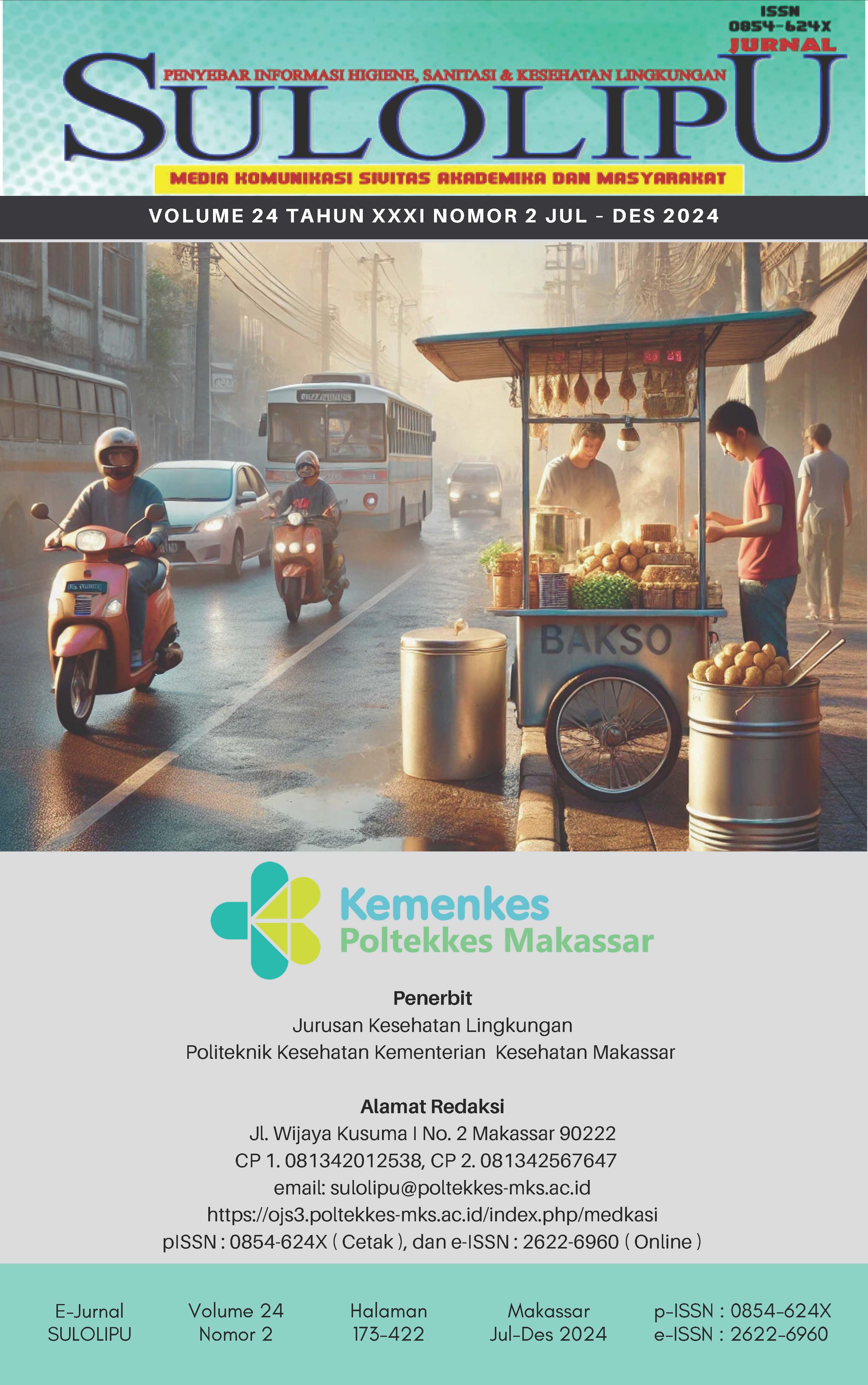Effectiveness Test of Alamanda Leaf (Allamanda cathartica L) against Larvicides of Aedes aegypti larvae
DOI:
https://doi.org/10.32382/sulo.v24i2.893Keywords:
Ekstrak Daun Alaman; Larvasida; Jentik Aedes aegyptiAbstract
Dengue fever is a serious public health problem, especially in endemic areas such as Indonesia. This disease can cause Extraordinary Events (KLB) with high mortality rates. Based on data from the Ministry of Health, until June 14, 2021, there were 16,320 cases of DHF in Indonesia, with an increase of 6,417 cases compared to the previous period. One of the efforts to control the spread of DHF is to kill Aedes aegypti mosquito larvae, the main vector of the disease. This study aims to determine the effectiveness of alamanda leaf extract (Allamanda cathartica L.) in killing Aedes aegypti larvae, using the Lethal Concentration 80 (LC80) indicator, which is the concentration that can kill 80% of the larval population. This study used a sample of 250 Aedes aegypti larvae with 3 replications for each treatment, consisting of 35%, 45%, and 50% concentrations of alamanda leaf extract, and 0% as control. The larvae were observed for 24 hours to determine the level of mortality caused by various concentrations of extracts. At 35% concentration, the total average mortality of larvae was 3 (12%). At 45% concentration, the average mortality increased to 5 (20%), and at 50% concentration, the average mortality remained at 5 (20%). These results indicate that the concentration of alamanda leaf extract used did not reach 80% mortality. Alamanda leaf extract at concentrations of 35%, 45%, and 50% is not yet effective for killing Aedes aegypti larvae because the resulting mortality percentage is still far from the LC80. Further research is needed to find more optimal concentrations or combine with other methods in mosquito larvae control.
Keywords: Alamanda Leaf Extract; Larvicide; Aedes aegypti larvae
References
Admin dinkes. (2016). Demam Berdarah Dengue (DBD). Dinkes Tanjung Pinang. https://dkp2kb.tanjungpinangkota.go.id/index.php/11-berita/21-demam-berdarah-dengue-dbd
Ara, M., Masud, M., Akter, K., Islam, M., & Ahmmed, A. (2022). Integrated management of purple blotch disease complex for onion seed production in bangladesh. Bangladesh Journal of Agriculture, 31-44. https://doi.org/10.3329/bjagri.v46i1-6.59971
Arfiani Nur, Ummy Yatul Jannah, S. S. (2020). Efektifitas Ekstrak Daun Allamanda Cathartica L.Dalam Membasmi Jentik Nyamuk. Jurnal Kesehatan Panrita Husada, 5, 2. http://ojs.stikespanritahusada.ac.id/index.php/jkph/article/view/338/179
Armayanti. (2019). Efektivitas Ekstrak Daun Mengkudu Dengan Metode Spray Dalam Pengendalian Nyamuk Aedes aegypti. Jurnal Sololipulipu, 19(2). http://journal.poltekkes-mks.ac.id/ojs2/index.php/Sulolipu/article/view/1349/881
Biologi, G. (2017). Ciri Morfologi Deskripsi Klasifikasi Manfaat Bunga Alamanda. https://generasibiologi.com/2017/07/ciri-morfologi-deskripsi-klasifikasi-manfaat-bunga-alamanda.htm
Eriawati. (2016). Pemanfaatan Tumbuhan di Lingkungan Sekolah Sebagai Media Alami Pada Materi Keanekaragaman Tumbuhsn di SMA Dan di Kecamatan Montasik. Jurnal Biotik, 4, 1. file:///C:/Users/Windows 7 x 4/Downloads/1070-2117-1-SM.pdf
Ferdian Ananda Manji. (2021). Waspada DBD. Media Indonesia. https://mediaindonesia.com/humaniora/412591/waspada-dbd-hingga-juni-tercatat-16320-kasus-dan-147-kematian
Flanter dan forester. (2020). Alamanda, Bunga Akar Kuning Allamanda catartica. Blogeer. https://www.planterandforester.com/2020/05/alamanda-bunga-akar-kuning-allamanda.html
Ilham. (2016). Di Bengkulu, Satu Jentik Nyamuk Bayar Rp 100 Ribu. Republik.Co.Id.Bengkulu. https://www.republika.co.id/berita/o2mdkq361/di-bengkulu-satu-jentik-nyamuk-bayar-rp-100-ribu
Kementrian Kesehatan Republik Indonesia. (2017). Info Datin Situasi Demam Berdarah Dengue 2017. file:///C:/Users/Windows 7 x 4/Downloads/InfoDatin-Situasi-Demam-Berdarah-Dengue.pdf
Kulu, I. P. (2021). Efektivitas pemberian ekstrak daun pepaya (carica papaya l.) pada hama utama tanaman tomat (solanum lycopersicum l.) di desa bukit pinang, kecamatan pahandut, kota palangka raya. Jurnal Penelitian UPR, 1(2), 108-121. https://doi.org/10.52850/jptupr.v1i2.9152.
Maulana Nurismi. (2021). Uji Kemampuan Daun Teh Hijau (Camellia Sinensis) Dalam Mematikan Nyamuk Aedes aegypti Dengan Menggunakan Elektrik Alat Hit (Studi Eksperimen). Jurnal Sololipu, 21(2). http://journal.poltekkes-mks.ac.id/ojs2/index.php/Sulolipu/article/view/2367/1598
Mentari, G. D. (2022). Kemenkes: Jentik Nyamuk Tidak Hilang Hanya di Kuras. Antara News.
Nadifah, Muhajir, Arisandi, L. (2016). Identifikasi Larva Nyamuk Pada Tempat Penampungan Air di Padukuhan Dero Condong Catur Kabupaten Sleman. Jurnal Kesehatan Masyarakat Andalas, 4(2). http://jurnal.fkm.unand.ac.id/index.php/jkma/article/view/203/217
Petricevich, V. L., & Abarca-Vargas, R. (2019). Allamanda cathartica: A review of the phytochemistry, pharmacology, toxicology, and biotechnology. Jurnal Molecules. https://doi.org/10.3390/molecules24071238
Rakhman Abdur. (2019). Uji Resistensi LambdacyhLothrin Terhadap Nyamuk Aedes aegypti di Wilayah Pelabuhan Laut. Jurnal Kesehtan Lingkungan, 16(1). file:///C:/Users/Windows 7 x 4/Downloads/156-552-1-PB (2).pdf
Republik Indonesia. (2017). Permenke No.50 Tahun2017 Tentang Standar Baku Mutu Kesehatan Lingkungan dan Persyaratan Kesehatan untuk Vektor dan Binatang Pembawa Penyakit Serta Pengendaliannya.
Rini Fitrianingsih. (2018). Jentik nyamuk Aedes aegypti Daur Hidup Nyamuk. Diary By Karo. https://diary-by-karol.blogspot.com/2018/08/20-trend-terbaru-jentik-nyamuk-aedes.html
Sherly Malakiano. (2019). Uji Efektivitas Larvasida Ekstrak Etanol Daun Alamanda (Allamanda cathartica L.) Terhadap Larva Aedes aegypti. Jurnal Scholar. https://scholar.googleusercontent.com/scholar?q=cache:96xwNImXvYoJ:scholar.google.com/+ekstrak+daun+alamanda&hl=id&as_sdt=0,5
Siswanto Usnawati. (2019). Epidemologi Demam Berdarah. https://repository.unmul.ac.id/bitstream/handle/123456789/3760/Epidemiologi Demam Berdarah_Siswanto.pdf?sequence=1&isAllowed=y
Subuh, M. (2017). Pendoman Pencegahan dan Pengendalian Demam Berdarah Dengue di Indonesia. https://www.dinkes.pulangpisaukab.go.id/wp-content/uploads/2020/09/Isi-Buku-DBD-2017.pdf
Susanti dan Surharyo. (2017). Hubungan Lingkungan Fisik Dengan Keberadaan Jentik Aedes Pada Area Bervegetasi Pohon Pisang. Unnes Journal of Public Health, 06, 3. https://journal.unnes.ac.id/sju/index.php/ujph/article/view/15236
Titi Fatmawati. (2014). Distribusi dan Kelimpahan Larva Nyamuk Aedes spp. di Kelurahan Sukorejo Gunungpati Semarang Berdasarkan Peletakan Ovitrap. http://lib.unnes.ac.id/20178/1/4411409013.pdf
Wahyuni M. Kes, H. D. (2016). Toksisitas Ekstrak Tanaman Sebagai Bahan Dasar Biopestisida Baru Pembasmi Larva Nyamuk Aedes aegypti (Ekstrak Daun Sirih, Ekstrak Biji Pepaya, Dan Ekstrak Biji Srikaya). In Media Nusa Creative.
Wati, N., Rahmawati, L., & Sampirlan. (2021). Penggunaan Metode Stek Untuk Perbanyakan Tanaman Alamanda (Allamanda cathartica). Journal Ar-Raniri. file:///C:/Users/Windows 7 x 4/Downloads/803-Article Text-1760-1-10-20210318.pdf
Downloads
Published
How to Cite
Issue
Section
PDF (Bahasa Indonesia) downloaded: 497



















